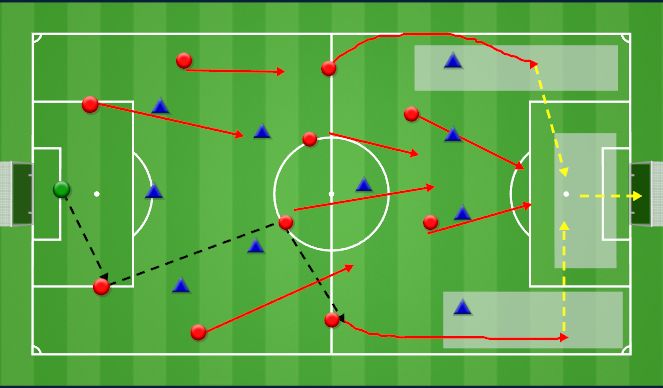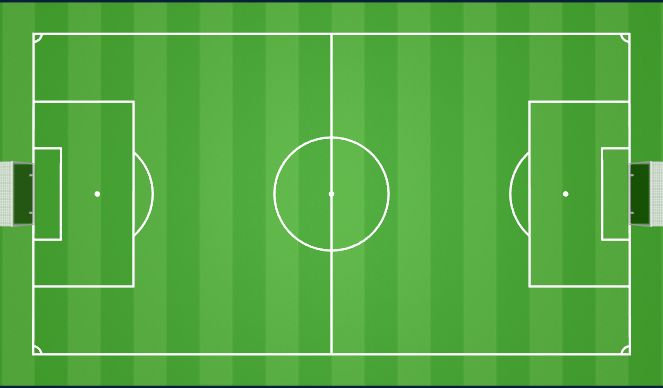Football/Soccer Session (Academy Sessions): MATCH DAY PLANNING BEFORE THE GAME

Profile Summary

| Name: | Rodgers Mogusu |
|---|---|
| City: | Cardiff |
| Country: | United Kingdom |
| Membership: | Adult Member |
| Sport: | Football/Soccer |
Description
We look at some of the key factors in preparing for a game. We consider the basic information we need to give to our team, the things we need to know about our players and how we can prepare strategies and tactics for our team.
See the guidance at the top of this page to understand why you are not seeing interactive Football/Soccer images.

Screen 2 (45 mins)
Choosing System of Playing.
After establishing what our players can and cannot do, we can turn our attention to choosing a system of play.
Systems of play or formations give our team and players organisation, a structure to play from and an area of the field to operate in. A system of play will contain a defensive, midfield, and attacking unit. The number of players in each unit will vary depending on the system of play being used
The environment in which you coach may also affect which system you decide to use. In a performance environment, you may decide to shape the system to the player's capabilities and look to enhance your team's individual and collective strengths while mitigating potential weaknesses. In a development setting the system may be prescribed by the club to develop a specific type of player in line with their outlook and beliefs of the game. In addition to this, the coach may decide that a particular system affords development opportunities for their players to improve any potential weaknesses by placing them in situations they are not comfortable with or areas of the field where they can improve a specific skill set. When we consider the strengths of the players within our team we can start to paint a picture of how best we can attack and defend.Strategy and Tactics.Strategy is the overall action plan that we choose for the game and tactics are the things we will do to bring the strategy to life. To build an overarching strategy and decide on which tactics the team will employ during the game, coaches need to decide on what they want the team to do in each of the main moments of the game and in which part of the field they want them to do it.
Strategy:
To create goal-scoring opportunities we will look to play to our team's strengths and attack the wide areas of the field.
Tactics:
Defence: Build play centrally using our Central Defenders’ passing ability to find passes through the opposition's first line of defence, find one of our Central Midfielders and draw the Defending team towards the ball, creating space for our wide players.
Mid-field: Once we have progressed the ball into Midfield we will look to exploit the space we have created in the wide areas by distributing the ball to the wide areas of the pitch quickly and looking to play passes beyond the opposition back four for our wide midfielders to run onto as a first option. If we cannot play beyond we should look to play to the feet of our wide players and isolate the opposition's Full Backs in 1v1 situations.
Attacking: When the ball has progressed to the final third we will look to cross the ball into the box for our two Forwards, opposite side wide player and Attacking Midfielder to Attack.
Match & Learning Objectives
To underpin player learning, and transfer training to the game, coaches may decide to set team, unit and individual learning objectives or tasks relating to the execution of the team’s strategy and tactics.
For example -
- Wide players, can you deliver three successful crosses each in both halves of the match?
- Central Defenders, can you play five successful passes to our central midfield players in each half of the match?
Match and learning objectives are a great way to provide detail to players regarding roles and responsibilities, they also provide us with an objective way of defining what success looks like regardless of the result.









 Play animation
Play animation Play step-by-step
Play step-by-step Repeat (toggle)
Repeat (toggle) Full Screen
Full Screen Pause
Pause Stop
Stop
Screen 1 (45 mins)
Match Planning.
Match planning is a key ingredient in preparing our team for match day. By taking a structured approach to planning out the day we can ensure all variables under our control run as smoothly as possible.
Match planning is not just as simple as selecting which players will feature in the game and choosing a system of play. There is a multitude of considerations we must take into account as coaches in order to give our players the best chance of performing well.
Just as with any training session, we need to ensure that thorough consideration and planning is given to how we will go about our matchday.
Why is planning important.
‘Poor planning leads to poor performance’ is an axiom we are all familiar with. By setting out objectives, creating plans and having a structure to work from, we can create meaningful footballing experiences for our players and give them a platform to perform well. If we approach match day with an inconsistent approach we will get nonchalant performances and struggle for any semblance of consistency on an individual and collective level.
Before Match Day, there are some basic pieces of information we need to share with our team to ensure everybody gets to the right place and on time.
- Who are we playing.
- Where are we playing.
- What time do our players need to arrive.
- What kit do players need to bring.
- Kick off time.
The Match Day TimelineTo ensure a smooth build-up to the game, coaches may want to create a timeline to organise both their own and their player's time. By creating a timeline of events we can work out how long we need to complete all our pre-match tasks, give players the time to prepare for the game and ultimately reduce any unwanted stress on the group.
Pre-match timeline.
Coach arrives,Check/set up the pitch,Set up kit,set up warm up,players arrive,prematch talk,warm,final details and then Kick off.
Choosing Players.
Before we can choose a system of play we need to know what our players can and cannot do.
Consideration must be given to each player's unique strengths, sometimes referred to as a player’s superpowers. These abilities may be technical, such as passing range or the ability to dribble the ball, physical abilities such as speed or strength, psychological abilities such as reading the game, and Social abilities like communication. Coaches must also be objectively honest about any areas players struggle with.
We can divide our players into one of three main categories, with some players spanning more than one.
By profiling our players accurately, coaches can establish where players are best suited to play on the field, create favourable matchups against opposing players and identify any development opportunities for players.